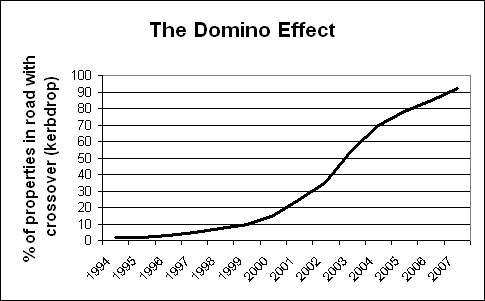
Installing pavement crossovers (kerb drops) so that people can park in their front gardens reduces the amount of on-road parking available. The less on-road parking there is, the more people apply for crossovers to park in their front gardens, setting up a Domino effect.
To park in a front garden, residents require a Council-approved pavement crossover (kerb drop) to allow a vehicle to drive across the pavement. Once a crossover is in place, it effectively prevents anyone else parking on that stretch of road, as this picture shows.
So there's less parking space in the road. So more residents apply for crossovers to park in their front gardens. So there's even less parking space. So parking becomes even more difficult, and so on.
The result is a Domino Effect as more and more front gardens are converted for parking. The graph below shows the rate of increase in crossovers in a typical road in the London Borough of Ealing.

In just a few years, nearly all the front gardens in a road can become car parks. The character of a road can change completely from one where every house has a front garden to one where there are hardly any front gardens left.
Here are two views of the same road in Greenford, taken from the same spot. Looking one way: a traditional suburban street, with front gardens, hedges, trees and cars parked on the road. Looking the other way: crossovers installed, front gardens hard surfaced, hedges, trees and gardens all gone and the cars parked in the gardens. There are no cars parked on the road where the crossovers are. The furthest front garden is in the process of being concreted over.

Crossovers are 'permitted development' under the Town & Country Planning (General Permitted Development) Order 1995. This means that crossovers do not need planning permission, except in certain conservation areas, and councils have to have good reasons not to approve them.
Despite pressure from the London Assembly and others, the Government made no changes to the permitted development regulations when it reviewed them in 2008. See Why Are People Paving Over Their Front Gardens?, Legislation and What You Can Do pages for more information.
Illegal Crossovers
Of course, it's not difficult for people to concrete their front gardens and just drive their vehicles across the pavement without a Council-approved crossover. This is illegal but widespread, and enforcement is resource-intensive and consequently may not be pursued. Our survey estimated that there could be as many as 4,800 front gardens being used for parking without an approved crossover in the London Borough of Ealing.
The front garden on the right of the one being paved has no crossover, yet is being used for parking.



